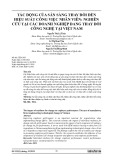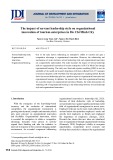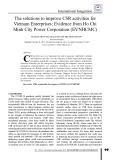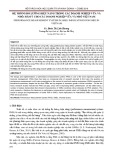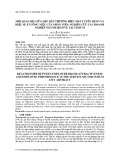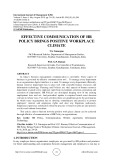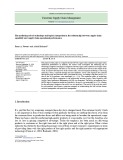
* Corresponding author
E-mail address:mhisham@uum.edu.my (H. Bin Mohammad)
© 2019 by the authors; licensee Growing Science, Canada
doi: 10.5267/j.uscm.2018.8.001
Uncertain Supply Chain Management 7 (2019) 311–328
Contents lists available at GrowingScience
Uncertain Supply Chain Management
homepage: www.GrowingScience.com/uscm
The effect of integration between audit and leadership on supply chain performance: Evidence from
UK based supply chain companies
Waseem Ul-Hameeda, Hisham Bin Mohammadb*, Hanita Binti Kadir Shaharb, Ahmad Ibrahim
Aljumahc and Syafiqah Binti Azizana
aSchool of Economics, Finance & Banking (SEFB), College of Business (COB), Universiti Utara Malaysia (UUM), Malaysia
bSenior Lecturer, School of Economics, Finance & Banking, Universiti Utara Malaysia (UUM), Malaysia
cSchool of Business Innovation and Technopreneurship, Universiti Malaysia Perlis, Malaysia
C H R O N I C L E A B S T R A C T
Article history:
Received July 1, 2018
Accepted August 6 2018
Available online
August 6 2018
Supply chain performance has been a key element of competitive strategy to boost
organizational productivity and profitability. In the United Kingdom (UK), a survey disclosed
that approximately 40% of the UK’s gross domestic product (GDP) was consumed on supply
chain related activities. Because of the extensive use of gross domestic product (GDP) on
supply chain, it is important to work on UK based supply chain companies and to reveal various
factors to enhance supply chain performance. Therefore, the primary objective of the current
study is to investigate the combine effect of audit determinants and leadership styles to enhance
supply chain performance in UK based companies. Data were collected from audit department
employees and other managerial employees who are closely related to supply chain activities.
After analyzing the data through Smart PLS 3, it was found that audit and leadership styles
played important contribution in supply chain performance. Moreover, top management and
employee commitment to change maintained significant influence to enhance positive effect
on audit and leadership. This study is much significant for UK supply chain companies to
enhance supply chain performance.
ensee Growin
g
Science, Canada© 2018 b
y
the authors; lic
Keywords:
Supply chain performance
Audit
Leadership styles
Top management
Employee commitment
1. Introduction
Supply chain performance has been a key element of competitive strategy to boost organizational
productivity and profitability (Gunasekaran et al., 2004; Palandeng et al., 2018; Singh et al., 2018;
Imran et al., 2018). Now a day, supply chain management, analysis, and development are becoming
increasingly important. It is evident from literature that various methods to supply chain management
are available (see, for instance, Bytheway, 1995a; 1995b; Lamming, 1996; New, 1996; Waters-Fuller,
1995). However, still a gap exists, which is needed to be filled to boost up supply chain performance,
particularly in United Kingdom (UK) based companies. In the UK, a survey disclosed that
approximately 40% of the UK’s gross domestic product (GDP) was consumed on supply chain related
activities (Gunasekaran et al., 2004). Therefore, such type of findings and developments show
noteworthy visible impact of supply chain management on company assets and UK’s economy. Most

312
of the managers in manufacturing organization majorly focus on supply chain performance. As it plays
vital role in cost management and overall company’s profitability. Hence, because of the extensive use
of gross domestic product (GDP) on supply chain, it is important to work on UK based supply chain
companies and to reveal various factors to enhance supply chain performance.
It is evident from the literature that many factors affect the supply chain performance. However, the
most important factors are audit determinants and leadership. Audit is one of the factor, which
minimizes the enterprise risk (Hameed et al., 2017) and decreases the cost of supply chain process by
presenting the true and faire view of company’s financial statements. Determinants of audit, namely;
competency of internal audit department (Alzeban & Gwilliam, 2014; George et al., 2015) and
relationship between internal and external auditor’s (Alzeban & Gwilliam, 2014; Corina-Maria, 2014)
has link with supply chain performance. These two determinants have significant influence on supply
chain performance.
Moreover, leadership also has significant association with supply chain performance. Leadership is
much important for any organization (Haider et al., 2018). An effective leadership leads the employees
to use resource effectively and efficiently. It increases the performance of employees which ultimately
influences positively on supply chain performance. However, two forms of leadership; transformational
leadership and transactional leadership (Avolio & Bass, 2004) are more important to lead employees
in right direction. Therefore, audit practices and leadership are more important to enhance supply chain
performance in UK.
Additionally, audit effectiveness for supply chain performance can be enhanced through better top
management support for audit practices. As the top management support has significant influence on
audit practices (Alzeban & Gwilliam, 2014; George et al., 2015). Furthermore, leadership is only
effective if the employees want to adopt change and committed to absorb change as the employee
commitment to change is most important in any organization (Herscovitch & Meyer, 2002). Thus, to
transfer the positive effect of leadership on supply chain performance, employee commitment to change
is most crucial. The combination of all these factors are shown in Fig. 1, which is the proposed
framework of the current study.
The literature on supply chain performance that deals with different strategies as well as technologies
for successfully managing a supply chain is quite vast (Gunasekaran et al., 2004). Various studies
discuss supply chain performance (see, for example, Divyaranjani, 2018; Saleheen et al., 2018;
Tarafdar, & Qrunfleh, 2017; Thanki, & Thakkar, 2018), however, in rare cases any study documented
the combination of audit practices and leadership to boost the supply chain performance.
Therefore, the primary objective of the current study is to investigate the combine effect of audit
determinants and leadership to enhance supply chain performance in UK based companies. However,
the study has sub-objectives;
1. To investigate the role of audit determinants in supply chain performance,
1.1. To examine the effect of competency of internal audit department and relationship between
internal and external auditors on supply chain performance,
1.2. To examine the moderating role of supply chain top management support,
2. To investigate the role of leadership in supply chain performance,
2.1. To examine the effect of transformational leadership and transactional leadership on
supply chain performance,
2.2. To examine the moderating role of supply chain employee’s commitment to change,

W. Ul-Hameed et al. / Uncertain Supply Chain Management
7 (2019)
313
Fig. 1. Theoretical Framework
The current study contributed in the body of knowledge by investigating the combine effect of audit
determinants and leadership to enhance the supply chain performance in UK. Additionally, the study
investigated the moderating variables; supply chain top management and supply chain employee
commitment for change.
2. Review of Literature
2.1 Audit Determinents, Supply Chain Top Management Support and Supply Chain Performacne
Technical competence of every audit committee has significant role in enhancing the effectiveness of
audit. According to Mihret Kieran and Mula (2010), training provides competency to internal activities.
Moreover, Cohen and Sayag (2010) explained that the professional competence of internal or external
auditors is the fundamental factor that effect on the effectiveness of audit. Competency of internal audit
has positive linkage with effectiveness (Alzeban & Gwilliam, 2014).
The competency in audit department plays an important role to show the true and fair view of statement
of concerned company. This true and fair view is one of the indications of smooth supply chain
performance. As risk is an important factor in every organization (Hameed et al., 2017). Good audit
practices maximize the enterprise risk management, which enhance the supply chain performance.
Staff competence is a key to the internal audit effectiveness (Al Twaijry et al. 2003; Alzeban &
Gwilliam 2014). The ISPPIA shows the significance of internal audit team who owns the knowledge,
competencies and other skills prerequisite to perform audit function (ISPPIA Standard 1210).
Definitely, it is important for internal auditors to have the essential education and other professional

314
qualifications (Mihret, & Yismaw, 2008). As the supply chain is one of the component of organization,
therefore, an increase in overall performance is the indication to increase in supply chain performance.
Hence, good internal audit practices with the help of competency increases the external audit results.
Positive auditor’s results are one of the guaranties of good operations in supply chain companies. It
shows that competency of internal audit department has important link with supply chain performance.
Thus, it is hypothesized that;
H1: There is a significant relationship between competency of internal audit department and supply
chain performance.
The effectiveness of audit is mainly dependent on the relationship between internal as well as external
audit departments. This relationship certifies an effective communication as well as coordination
between internal and external audit. The coordination between them includes exchange of various
documented information as well as assistance of audit process. Many previous studies (see, for
example, Almohaimeed, 2000; Brierley et al., 2001; Golen, 2008; Gwilliam & El-Nafabi, 2002) focus
on the impact of the relationship between internal and external audit department on the audit
effectiveness.
The communication of various internal and external auditing movements is significant from different
perspectives: firstly, external audit because in this process, financial statements accuracy can be
enhanced by them; secondly coordination between internal and external auditors helps in risk control
aspect (Dobroţeanu, & Dobroţeanu, 2002). Increase in risk control increases the supply chain functions
effectiveness and it is based on audit department competency.
Relationship between internal auditors and external auditors enhances the audit performance and
increase in audit performance is one of the indication of smooth operations, as discussed earlier. Smooth
operations are one of the guaranties of good supply chain practices. Thus, it is hypothesized that;
H2: There is a significant relationship between internal auditors, and external auditor’s department and
supply chain performance.
Top management support is one of the most significant factors that can increase the effectiveness of
audit committee. Literature shows that management support is an important element for various
activities of audit. For instance, Mihret and Yismaw (2007) investigated a positive link between the
management support and effectiveness of audit. Therefore, management support in supply chain
companies promote audit practices which increase the supply chain performance.
In line with Cohen and Sayag (2010), other studies also disclosed that management support is a vital
determinant of internal audit effectiveness in all companies. Furthermore, Alzeban and Gwilliam
(2014) supported the positive association between the management support and internal audit. It has
the ability to enhance the positive relationship between internal auditors and external auditors in supply
chain companies.
Internal auditors must shape a close relationship with top management support to achieve their
monotonous activities. For good audit activities, auditors require positive support from the higher-level
management to achieve their work more effectively according to main goals. Top management support
is a factor which can take the various shapes like the support of audit through providing essential
resources. These various resources may be in form of financial resources, non-financial resources such
as training, management support, other transport facility, technology with latest procedures,
professional certificates funds etc. (Alzeban & Gwilliam 2014; Hailemariam, 2014). Hence, below
hypotheses are proposed;

W. Ul-Hameed et al. / Uncertain Supply Chain Management 7 (2019)
315
H3: Supply chain top management support moderates the relationship between competency of internal
audit department and supply chain performance.
H4: Supply chain top management support moderates the relationship between relationship of internal
auditors and external auditors, and supply chain performance.
2.2 Leadership Styles, Supply Chain Employee’s Commitement for Change and Supply Chain
performance
Leaders have two basic personalities; transformational leadership and transactional leadership (Weber,
1947). Bureaucratic leader is a transactional leader and a charismatic leader is a transformational leader.
Both leadership styles have significant influence on supply chain performance. Eisenbach et al. (1999)
and Herold et al., (2008) postulated that leadership style and organizational change are integrated.
Transformational leadership can be viewed as “the process of influencing major changes in the attitudes
and assumptions of organization members and building commitment for the organization’s mission or
objectives” (Yukl, 1989). Bass and Steidlmeier (1999) specified that transformational leadership rises
the area of effective freedom, and the area for work intention. Researches have been carried out as far
back as in the 1980s on how transformational leadership affect change (Bass, 1985; Bennis & Nanus,
1985).
According to Burns (1978), transformational leadership is a way to increase an organization’s necessity
for change to an advanced level of development. The author also explained transformational leaders as
one of the ordinary agents which can empower subordinates to work on a mission and proper
implementation. According to Bass (1985, 1990), transformational leadership emphases on the unique
behavior of employees of organization that may influence their behavior same with the organizational
direction which can change the vital values, beliefs as well as attitudes.
This leadership style always inspires subordinates to search for new methods in carrying out their job
from inspiring motivation to knowledgeable stimulation. Ismail et al. (2010) studied the link between
individual outcomes and transactional and transformational styles of leadership. Findings showed that
transformational style of leadership is a significant indicator of procedural justice, while transactional
style of leadership is a significant indicator of distributive justice, and that both leadership styles are
crucial indicators of trust in leaders which enhance readiness to change.
Kavanagh and Ashkanasy (2006) found out that there was an association between leadership style and
supporting cultural of employees to change. Authors further specified the leader's need to be sufficient
experienced to attain a high degree of commitment. It is also demonstrated that leadership was crucial
in increasing commitment to change among different employees.
The study of Limsila and Ogunlana (2008) supported the view that transformational style of leadership
is significantly related with employee commitment to change; they found that such leadership style had
a positive and significant relationship with organizational commitment of followers compared with the
transactional kind of leadership. This level of commitment has influence on satisfaction (Hussain et al.,
2013) which influence on supply chain management. However, all these leadership styles have a link
with supply chain performance.
Notwithstanding the significance role of transformational leadership style on the organizational change,
examining the effect of transformational leadership style on employee readiness to change has been
ignored in the literature review, particularly in the literature of supply chain performance. Thus, this
study attempts to address this gap found in the organizational change and leadership literature in order
to get new and deep knowledge about such issue within supply chain performance. Therefore, following
hypotheses are proposed;

